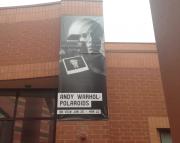Andy Warhol's Polaroids come to CSULA's Luckman Gallery
Listen to the full audio story
- Warhol Exhibit.mp3

Upon entering the Luckman Fine Arts Complex, visitors are greeted by a quote by Warhol that reads, “I want to be a machine, and I feel whatever I do and do machine-like is what I want to do.” It’s a fitting introduction to an exhibit dedicated to an artist who popularized the concept of mass-produced artwork.
But, while most associate Warhol with silkscreened images of celebrities and soup cans, few remember Warhol’s later forays in photography — specifically Polaroid photography.
Andy Warhol: Polaroids 1974 – 1987 brings together selected works from the thousands of Polaroid photographs Warhol took in the final years of his career.
Warhol’s polaroids capture a wide variety of subjects: Drag queens, children, members of the artist’s vast social circle. Creased and wilted – the photographs are in their original condition.
A collection of fifty-two intricately arranged black and white prints depict glamorous social events, mundane city life, and many of Warhol’s personal friends. Allen Ginsberg and Paul Getty make appearances amongst the exhibit’s many familiar faces.
Several portraits depict Warhol’s subjects photographed under different exposures in a variety of poses. These polaroids served as “sketches” for many of Warhol’s familiar silkscreen paintings. A lone image of an Uncle Sam can be matched up to the patriotic print he later created.
Three televisions screens loop a selection of Warhol’s infamous “Screen tests,” an experimental silent portrait series filmed between 1964 and 1966. He captures candid footage which he called Living Portrait Boxes. As subjects stare into the camera for at least four minutes, spectators can sense the intense vulnerability emanating through the screen. For Warhol fans, Edie Sedgwick’s face will immediately stand out. One of “Warhol’s superstars,” she remains a fashion and pop culture icon even after her tragic death in 1971.
Around the corner, a projection room plays silent archival footage set to the song “Faces and Names.” Scenes include Bob Dylan in The Factory and even Warhol using a Polaroid camera. It's a rare glimpse into the larger than life eccentricities of the beloved artist.
The exhibit invites visitors to join Warhol’s legacy by leaving behind their own polaroids. Organizers believe Warhol would have been an avid fan of social media — especially apps like Instagram that encourage photo manipulation and image sharing. Visitors are encouraged to post photos with custom hashtags. Who knows, that hashtag could be your ticket to fame. As Warhol would say, “In the future, everyone will be world-famous for 15 minutes.”
Check out the future home of Annenberg student media:

Wallis Annenberg Hall
(opening Fall 2014)

